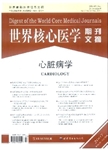一组孤立性房颤患者行导管射频消融术1年后左侧心腔重构发生逆转
Reverse remodeling of the left cardiac chambers after catheter ablation after 1 year in a series of patients with isolated atrial fibrillation出 版 物:《世界核心医学期刊文摘(心脏病学分册)》 (Digest of the World Core Medical Journals(Cardiology))
年 卷 期:2006年第4期
页 面:51-51页
学科分类:1002[医学-临床医学] 100201[医学-内科学(含:心血管病、血液病、呼吸系病、消化系病、内分泌与代谢病、肾病、风湿病、传染病)] 10[医学]
摘 要:Background -Isolated atrial fibrillation(AF)is associated with mild enlargement of the left atrium(LA)and left ventricular(LV)diastolic dysfunction. The impact of ablation of isolated AF on left chamber size and function is unclear, and whether diastolic dysfunction is the cause or the consequence of AF remains unknown. The objective of this prospective study was to evaluate the impact of sinus rhythm restoration by catheter ablation on LV diastolic dysfunction, LA morphology, and mechanical function. Methods and Results -Forty-eight patients with isolated AF were studied by serial echocardiographic studies at baseline and at 1-, 3-, 6-, 9-, and 12-month intervals after radiofrequency ablation. LA dimensions and mechanical function and LV systolic and diastolic functions were evaluated at each time interval. Diastolic function was assessed with conventional Doppler parameters and new indexes such as tissue Doppler imaging, mitral flow propagation velocity, and combined criteria. LV diastolic dysfunction was present in paroxysmal and chronic AF patients with a reduction of tissue Doppler imagin g lateral early diastolic peak velocity in 37%(P 0.001)and 48%(P 0.01), resp ectively, compared with healthy control subjects. At the end of the follow-up, LA area decreased significantly by 18%(P 0.001)in paroxysmal and 23%(P 0.05) in chronic AF patients. Diastolic function improved significantly with an increa se in lateral early diastolic peak velocity of 29%(P 0.001)in paroxysmal AF an d 46%(P 0.05)in chronic AF patients. A significant increase in LV ejection fra ction was also noted for both groups: 7.7%and 18.8%, respectively. Conclusions -This study demonstrates reverse morphological remodeling of the LA and improv ement of LV diastolic and systolic functions after restoration of sinus rhythm b y ablation for isolated AF. Because patients with isolated AF have none of the t raditional causes of LV diastolic dysfunction, our findings suggest that AF may be partly t



